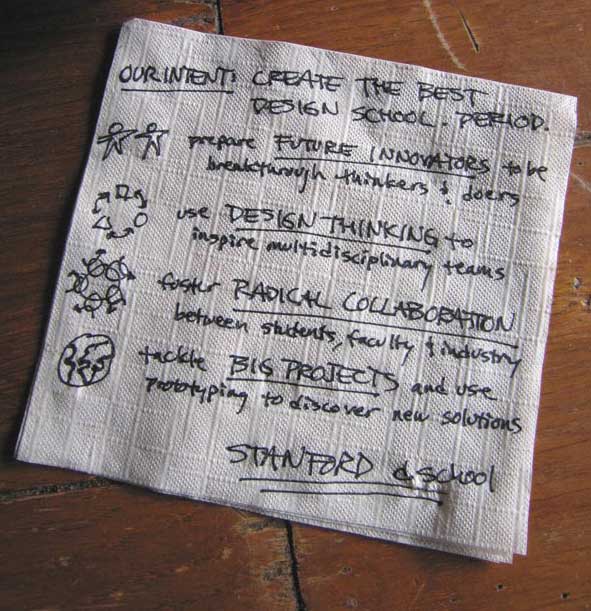A decade ago I worked with George Kembel to create the Stanford d.school’s “napkin manifesto”, a founding document written on a paper square that came free with a cup of coffee. The thoughts we committed to paper that day reflected an audacious goal: Create the best design school in the world, period. I think it’s safe to say that the d.school has been a remarkable success, having had an impact far beyond what even our visionary founder David Kelley imagined.
I’ve learned so much as a teacher during that time, too. I’ve witnessed not only the evolution of the d.school, but the power of design thinking at work in many other arenas—everything from the development of more humane medical technologies to improving school lunch programs. I’ve been honored to participate in helping design thinking become a core part of the curriculum and culture at both Stanford and Harvard Business School, and to teach the design process to the client organizations I work with at IDEO.
So how do you create a great design class? By applying design thinking, of course! In essence, the way to teach a great design thinking class is to treat it as a design project. In this particular case, I’ve found three principles that lead to classroom success, each of them inspired by some general precepts that always serve me well.
1. Design thinking rewards hands-on experience.
It sounds obvious, but to teach design thinking, you need to be able to do design thinking. In any job, whether you’re a carpenter or a bioengineer, understanding the work from the inside out is always the best qualification to pass those skills to others. As a teacher, you need to be an accomplished creator of things out in the world, a master of using design thinking to ship. Theory is valuable and required, but being adept at the practice is by far the most important driver of success for both your students and you.
2. Design thinking thrives on feedback and iteration.
The most important ritual of our classes at the d.school is the daily debrief session. Instead of running to their respective offices when class is over, the teaching team gathers at the back of the classroom, reflects on how the session went, and listens to students’ feedback. The teachers then change class plans, move sessions around, even rethink the approach of the entire course. To be sure, when I teach I have a strong goal for what the class should accomplish, but in response to what this group of students needs right now I’m able to adjust our path there on the fly. It’s about having a compass, not a map.
3. Design thinking solves real-world problems.
Classroom projects have to be structured without artificial constraints or boundaries. When students feel that they are working on a real problem, the sky is the limit—no essays or fake projects allowed. This transforms the class experience: instead of focusing on the grade they’ll receive by hurdling yet another academic annoyance, students genuinely feel they’re working to make a difference in the world. For example, if a class is about creating a business, students should create a real business. If it’s about improving the water supply in developing countries, they should build a solution that puts a clean glass of water in the hand of someone who needs it. Here’s my acid test: if a student so desired, could they build a career around this challenge I’m giving them?
By applying these three principles to the design of a design class, we aim to make the d.school classroom the best education experience each student has ever had. But there’s no secret at work here; the guidelines we use are universal to the design process: Have a strong point of view and confidence in what you do, proceed with empathy and openness to feedback, and offer real solutions that improve the lives of real people.

